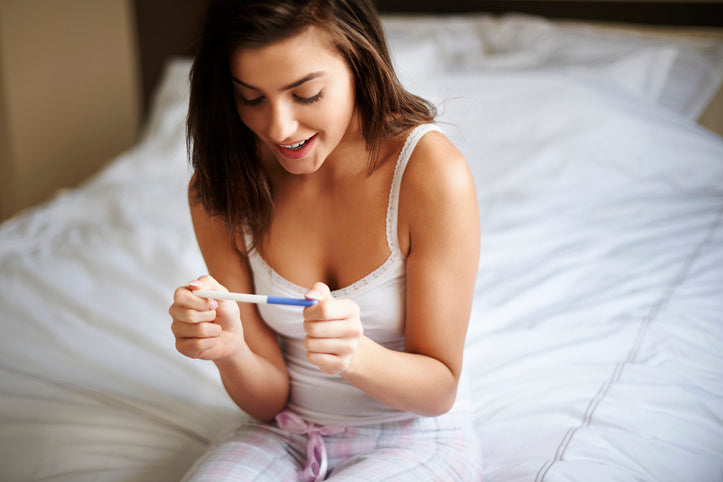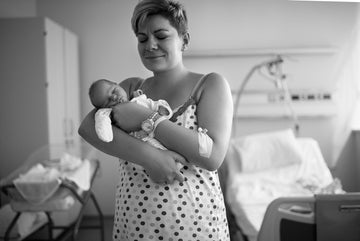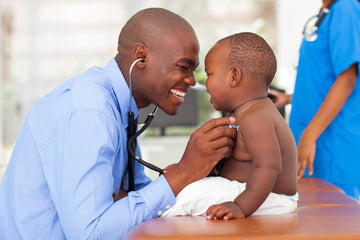A Baby's First Trimester

Fireworks occur at the moment you become pregnant. But that is not considered the first day of your pregnancy. For an easy formula to determine an approximate due date, birth workers consider the first day of your last period as the beginning of pregnancy. This is the day the first trimester begins. The body preps the uterine wall for a healthy attachment of a fertilized egg. Ovulation takes place, and the egg is penetrated by a sperm. This action is the moment of conception.
Every day after this is important, as that tiny egg is going to develop into a baby! Your baby’s sex was determined at conception. The egg and sperm each contribute one chromosome. The egg always carries an X; the sperm, either an X or a Y. If the fertilizing sperm contains an X chromosome, you will have a girl. If it contains a Y, you're having a boy. Although, you will not be able to see the gender until much farther into the pregnancy.
HCG is the key hormone that's present during pregnancy. It's produced by what ultimately becomes the placenta. Its basic job is to tell a woman's body that there is a life growing in her womb and that her body needs to protect and help it.
Once conception occurs, HCG halts the production of maturing eggs from the ovaries every month. HCG levels rise about eight days after ovulation. They peak at 60 to 90 days and then lower slightly, leveling off for the remainder of the pregnancy. A healthy pregnancy typically has HCG levels that double every two days from the moment of conception until about the tenth week. HCG is the hormone that pregnancy tests are confirming, as it is not present unless an egg was fertilized.
Progesterone is also produced after conception. A cyst on the ovary (called the corpus luteum) continues to produce progesterone until about 10 weeks, when its production is taken over by the placenta. In the first trimester, levels of progesterone rise exponentially, and then they plateau. Progesterone keeps the uterus muscle relaxed and plays a role in the immune system, helping the mother’s body tolerate the DNA of the baby. The fertilized egg, also known as a zygote, is the size of an apple seed when you can confirm that you're pregnant. Typically, this is about two weeks after conception, so four weeks into the first trimester. By week five, it's known as an embryo.

The Embryonic Stage
This stage runs from about the 5th through the 10th week of the first trimester of pregnancy. As an embryo, all of the baby’s major organs and body parts begin to develop. The cells of the embryo (called embryonic stem cells) multiply and change into the hundreds of different types of cells needed to make a whole human body.

What is developing:
Placenta: The placenta is an organ that does not exist unless pregnancy occurs. It is grown within the mother’s body and yet belongs to the baby, made up of both cells from mother and baby. Its job is the passing of nutrients and sustaining of life through the umbilical cord. The placenta first takes shape when cells from the fetus, called trophoblasts, attach to the uterus wall and then proceed to invade the tissues of the uterus. They eventually reach deep into the wall and connect with the mother's blood vessels. It attaches to the uterine wall with tiny projections called villi. Blood vessels from the baby grow from the umbilical cord into these villi and perform the exchanging of nourishment and waste products with the mother’s blood. The fetal blood vessels are separated from mother’s blood supply by a thin membrane. The placenta also functions as an endocrine organ, meaning it releases hormones, which enable both the mother and baby to have a successful pregnancy.
Umbilical cord: The umbilical cord is a ropelike cord connecting the fetus to the placenta. The umbilical cord contains two arteries and a vein, which carry oxygen and nutrients to the fetus and waste products away from the fetus.
Amniotic Sac: This sac is filled with amniotic fluid, and forms inside the uterus to surround and protect the baby. The amniotic fluid is liquid made by the fetus and the amnion (the membrane that covers the fetal side of the placenta) that protects the fetus from injury. It also helps to regulate the temperature of the fetus.
Nervous System: One of the first system to develop, the nervous system forms the brain, spinal cord, and nerves.
Heart: The baby's heart starts to beat at around 6 weeks. Prior to this, it is an S-shaped tube on the front of the embryo. Once it begins beating, it is pumping an early stage of blood. You may be able to hear or see the baby's heart beat for the first time around 7 weeks pregnant, if you have an early ultrasound exam.
Face: Facial features take shape and the eyes and ears form and are linked to the brain. Eyelids, forehead, nose, nasal passage, cheeks, lips, and jaw form. The mouth, tooth buds, and tongue with taste buds all develop.
Arms and Legs: Tiny buds turn into arms and legs with fingers and toes.
Sex Organs: The reproductive system has formed by the end of the first trimester, but it’s not possible on ultrasound to 100% determine boy versus girl.
Movement: Muscle development causes twitches and movements, but once the nerves and muscles work together, baby can move with purpose. A mother cannot feel these movements until farther along, as baby is too small at this point.
Growth: By week ten, the embryo is 1-1.5 inches in length.
At eight weeks, the embryo is officially a fetus and all organs have been formed. After 10 weeks, the placenta takes charge of producing progesterone and all other hormones. This is known as the Fetal Stage.

The Fetal Stage
Weeks 10, 11 and 12 are the beginning of the fetal stage.
Fingernails and toenails form.
Kidneys begin working.
Movement increases.
The baby has grown to 3-4 inches in length.
The fetus is most vulnerable during the first 12 weeks. During this period of time, all of the major organs and body systems are forming and can be damaged if the fetus is exposed to drugs, infectious agents, radiation, certain medications, tobacco and toxic substances. Even though the organs and body systems are fully formed by the end of 12 weeks, the fetus cannot survive independently.
Things to Note: Maternal stress can affect the embryo’s development. The first trimester of pregnancy is a crucial time for a baby’s hearth health later in life. Research shows that children who are small during the early stages of fetal development are at an increased risk of heart problems once they are older.
References:







